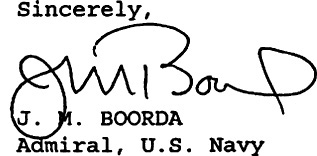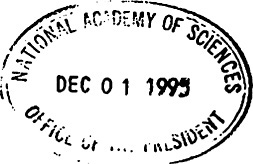
Dear Dr. Alberts,
In 1986, at the request of this office, the Academy’s Naval Studies Board undertook a study entitled “Implications of Advancing Technology for Naval Warfare in the Twenty-First Century.” The Navy-21 report, as it came to be called, projected the impact of evolving technologies on naval warfare out to the where 2035, and has been of significant value to naval planning over the intervening years. However, as was generally agreed at the time, the Navy and Marine Corps would derive maximum benefit from a periodic comprehensive review of the implications of advancing technology on future Navy and Marine Corps capabilities. In other words, at intervals of about ten years, the findings should be adjusted for unanticipated changes in technology, naval strategy, or national security requirements. In view of the momentous changes that have since taken place, particularly with national security requirements in the aftermath of the Cold War, I request that the Naval Studies Board immediately undertake a major review and revision of the earlier Navy-21 findings.
The attached Terms of Reference, developed in consultation between my staff and the Chairman and Director of the Naval Studies Board, indicate those topics which I believe should receive special attention. If you agree to accept this request, I would appreciate the results of the effort in 18 months.


TERMS OF REFERENCE
TECHNOLOGY FOR THE FUTURE NAVY
The Navy-21 study (Implications of Advancing Technology for Naval Warfare in the Twenty-First Century), initiated in 1986 and published in 1988, projected the impact of technology on the form and capability of the Navy to the year 2035. In view of the fundamental national and international changes -- especially the Cold War’s end -- that have occurred since 1988, it is timely to conduct a comprehensive review of the Navy-21 findings, and recast them, where needed, to reflect known and anticipated changes in the threat, naval missions, force levels, budget, manpower, as well as present or anticipated technical developments capable of providing cost effective leverage in an austere environment. Drawing upon its subsequent studies where appropriate, including the subpanel review in 1992 of the prior Navy-21 study, the Naval Studies Board is requested to undertake immediately a comprehensive review and update of its 1988 findings. In addition to identifying present and emerging technologies that relate to the full breadth of Navy and Marine Corps mission capabilities, specific attention also will be directed to reviewing and projecting developments and needs related to the following: (1) information warfare, electronic warfare, and the use of surveillance assets; (2) mine warfare and submarine warfare; (3) Navy and Marine Corps weaponry in the context of effectiveness on target; (4) issues in caring for and maximizing effectiveness of Navy and Marine Corps human resources. Specific attention should be directed, but not confined to, the following issues:
-
Recognizing the need to obtain maximum leverage from Navy and Marine Corps capital assets within existing and planned budgets, the review should place emphasis on surveying present and emerging technical opportunities to advance Navy and Marine Corps capabilities within these constraints. The review should include key military and civilian technologies that can affect Navy and Marine Corps future operations. This technical assessment should evaluate which science and technology research must be maintained in naval research laboratories as core requirements versus what research commercial industry can be relied upon to develop.
-
Information warfare, electronic warfare and the exploitation of surveillance assets, both through military and commercial developments, should receive special attention in the
-
review. The efforts should concentrate on information warfare, especially defensive measures that affordably provide the best capability.
-
Mine warfare and submarine warfare are two serious threats to future naval missions that can be anticipated with confidence, and should be treated accordingly in the review. This should include both new considerations, such as increased emphasis on shallow water operations, and current and future problems resident in projected worldwide undersea capability.
-
Technologies that may advance cruise and tactical ballistic missile defense and offensive capabilities beyond current system approaches should be examined. Counters to conventional, bacteriological, chemical and nuclear warheads should receive special attention.
-
The full range of Navy and Marine Corps weaponry should be reviewed in the light of new technologies to generate new and improved capabilities (for example, improved targeting and target recognition).
-
Navy and Marine Corps platforms, including propulsion systems, should be evaluated for suitability to future missions and operating environments. For example, compliance with environmental issues is becoming increasingly expensive for the naval service and affects operations. The review should take known issues into account, and anticipate those likely to affect the Navy and Marine Corps in the future.
-
In the future, Navy and Marine Corps personnel may be called upon to serve in non-traditional environments, and face new types of threats. Application of new technologies to the Navy’s medical and health care delivery systems should be assessed with these factors, as well as joint and coalition operations, reduced force and manpower levels, and the adequacy of specialized training in mind.
-
Efficient and effective use of personnel will be of critical importance. The impact of new technologies on personnel issues, such as education and training, recruitment, retention and motivation, and the efficient marriage of personnel and machines should be addressed in the review. A review of past practices in education and training would provide a useful adjunct.
-
Housing, barracks, MWR facilities, commissaries, child care, etc. are all part of the Quality of Life (QOL) of naval personnel. The study should evaluate how technology can be used to enhance QOL and should define militarily meaningful measures of effectiveness (for example, the impact on Navy readiness).
-
The naval service is increasingly dependent upon modeling and simulation. The study should review the overall architecture of models and simulation in the DoD (DoN, JCS, and OSD), the ability of models to represent real world situations, and their merits as tools upon which to make technical and force composition decisions.
The study should take 18 months and produce a single-volume overview report supported by task group reports (published either separately or as a single volume). Task group reports should be published as soon as completed to facilitate incorporation into the DoN planning and programming process. An overview briefing also should be produced that summarizes the contents of the overview report, including the major findings, conclusions, and recommendations.







